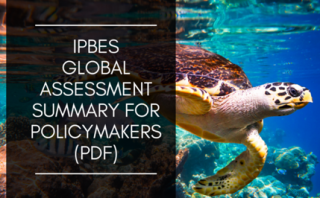Biodiversity and Ecosystem Services: A New Global Assessment by the United Nations
Brian M. Boom, Ph.D., is Vice President for Conservation Strategy at The New York Botanical Garden.

IPBES Global Assessment Summary for Policymakers, published May 6, 2019
Before this week, most readers probably had not heard of the Intergovernmental Science-Policy Platform on Biodiversity and Ecosystem Services (IPBES), but they certainly will know of its existence now. This United Nations group made major news this week, as reported in The New York Times, with publication of its first official report, the IPBES Global Assessment Summary for Policymakers. Among its major findings was that about one million plant and animal species are now threatened with extinction, many within decades, more than ever before in human history. The IPBES report makes an ironclad case for urgent global action to mitigate human-induced biodiversity loss before humanity crosses the fail-safe point.
The breathtakingly dire findings of the IPBES report were captured in the title and content of an analysis by Thomas E. Lovejoy, Ph.D., “Eden No More,” published in Science Advances this week. Dr. Lovejoy, an NYBG Trustee and Gold Medal recipient, elegantly explains what is meant by ecosystem services: “those charities of nature, both nebulous and tangible, that serve as the backbone of human well-being: food, fresh water, clean air, wood, fiber, genetic resources, and medicine.”
Dr. Lovejoy goes on to point out that one of the impediments to solving the biodiversity crisis is that ecosystem services, or the Contributions of Nature to People (CNP), are viewed as having little or no economic value. Currently, economic success is universally measured by Gross Domestic Product (GDP), and this calculus does not include CNP. Thus, the vast array of ecosystem services that serve as the backbone of human well-being goes largely unseen, unknown, and unsaved. We need to spread and internalize this vital, urgent message: Without CNP, there’s no GDP.
At NYBG, we are committed to fostering biophilia—people’s innate connection to nature—and to overcoming plant blindness—modern society’s inability to see and appreciate plants—through our programs in education, horticulture, and science. We call this urgent mission #plantlove, and through our programs we encourage people to see plants, get to know plants, and help save plants—all of which are required to effectively and positively respond to the grim assessments of the IPBES report.

Brazilian Modern: The Living Art of Roberto Burle Marx, a Garden-wide exhibition at NYBG, June 8–September 29, 2019
One example of how NYBG is helping people to see plants this summer is the Garden-wide exhibition Brazilian Modern: The Living Art of Roberto Burle Marx, on view June 8–September 29, 2019. Roberto Burle Marx (1909–94) was a force of nature in Brazil through his bold landscapes, vibrant art, and passionate commitment to plant conservation. His powerful modernist vision produced thousands of gardens and landscapes, including the famous curving mosaic walkways at Copacabana Beach in Rio de Janeiro and the beautiful rooftop garden at Banco Safra in São Paulo. One will be able to feel his artistic energy and love of plants through this exhibition of lush gardens, paintings, drawings, textiles, and the sights and sounds of Brazil that inspired his life and work. Watch a video about Roberto Burle Marx and the exhibition, narrated by guest designer Raymond Jungles.

Citizen scientists documenting tree-of-heaven (Ailanthus altissima) at Newtown Creek, New York City, July 2018
An example of how NYBG helps people to save plants is our Citizen Science projects. Data collected by volunteer citizen scientists can be used to inform policymakers about the endangered places and plants that need saving. Citizen scientists can contribute to scientific research from anywhere by helping botanists interpret herbarium specimens through a Virtual Herbarium Expedition. In the New York City EcoFlora project, data from herbarium specimens along with data collected by citizen scientists are uploaded to the Global Biodiversity Information Facility (GBIF), through which they are used in the conservation assessments of plant, fungal, and animal species for The IUCN Red List of Threatened Species™.
Dr. Lovejoy characterizes the IPBES report’s findings as “more than sobering,” but he concludes that there is hope for biodiversity and ecosystem services because there are “new and hopeful visions emerging from the conservation community that adjust the scale and impact of collective efforts upward dramatically.” Let us each be part of the solution, embracing and sharing #plantlove and my “executive summary” of the IPBES report: Without CNP, there’s no GDP.
SUBSCRIBE
Enter your email address to subscribe to this blog and receive updates on new posts.











